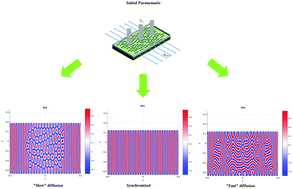当前位置:
X-MOL 学术
›
Soft Matter
›
论文详情
Our official English website, www.x-mol.net, welcomes your
feedback! (Note: you will need to create a separate account there.)
Biological plywood film formation from para-nematic liquid crystalline organization
Soft Matter ( IF 2.9 ) Pub Date : 2017-10-20 00:00:00 , DOI: 10.1039/c7sm01865g Oscar F. Aguilar Gutierrez 1, 2, 3, 4 , Alejandro D. Rey 1, 2, 3, 4
Soft Matter ( IF 2.9 ) Pub Date : 2017-10-20 00:00:00 , DOI: 10.1039/c7sm01865g Oscar F. Aguilar Gutierrez 1, 2, 3, 4 , Alejandro D. Rey 1, 2, 3, 4
Affiliation

|
In vitro non-equilibrium chiral phase ordering processes of biomacromolecular solutions offer a systematic and reproducible way of generating material architectures found in Nature, such as biological plywoods. Accelerated progress in biomimetic engineering of mesoscopic plywoods and other fibrous structures requires a fundamental understanding of processing and transport principles. In this work we focus on collagen I based materials and structures to find processing conditions that lead to defect-free collagen films displaying the helicoidal plywood architecture. Here we report experimentally-guided theory and simulations of the chiral phase ordering of collagen molecules through water solvent evaporation of pre-aligned dilute collagen solutions. We develop, implement and a posteriori validate an integrated liquid crystal chiral phase ordering-water transport model that captures the essential features of spatio-temporal chiral structure formation in shrinking film domains due to directed water loss. Three microstructural (texture) modes are identified depending on the particular value of the time-scale ratio defined by collagen rotational diffusion to water translational diffusion. The magnitude of the time scale ratio provides the conditions for the synchronization of the helical axis morphogenesis with the increase in the mesogen concentration due to water loss. Slower than critical water removal rates leads to internal multiaxial cellular patterns, reminiscent of the classical columnar-equiaxed metallurgical casting structures. Excessive water removal rates lead to destabilization of the chiral axis and multidomain defected films. The predictions of the integrated model are in qualitative agreement with experimental results and can potentially guide solution processing of other bio-related mesogenic solutions that seek to mimic the architecture of biological fibrous composites.
中文翻译:

准向列液晶组织形成的生物胶合板成膜
生物大分子溶液的体外非平衡手性相有序过程为生成自然界中发现的材料结构(例如生物胶合板)提供了系统且可重现的方式。介观胶合板和其他纤维结构仿生工程的加速进展需要对加工和运输原理有基本的了解。在这项工作中,我们重点研究基于胶原蛋白I的材料和结构,以找到能够产生无缺陷的胶原膜的加工条件,从而展现出螺旋胶合板的结构。在这里,我们报告实验指导理论和胶原蛋白分子的手性相顺序的模拟,该方法是通过预先对齐的稀胶原溶液的水溶剂蒸发。我们开发,实施和后验验证了集成的液晶手性相有序水传输模型,该模型捕获了由于有方向的水流失而在收缩膜域中形成时空手性结构的基本特征。根据胶原旋转扩散与水平移扩散所定义的时间比例的特定值,可以识别出三种微观结构(纹理)模式。时标比例的大小为螺旋轴形态发生与因水分流失引起的液晶元浓度的增加提供了同步条件。低于临界的水去除速率会导致内部多轴孔型,使人想起经典的柱状等腰冶金铸造结构。过多的水去除速率导致手性轴和多畴缺陷膜的不稳定。集成模型的预测与实验结果在质量上吻合,并且可以潜在地指导其他生物相关介晶溶液的溶液处理,这些溶液试图模仿生物纤维复合材料的结构。
更新日期:2017-11-15
中文翻译:

准向列液晶组织形成的生物胶合板成膜
生物大分子溶液的体外非平衡手性相有序过程为生成自然界中发现的材料结构(例如生物胶合板)提供了系统且可重现的方式。介观胶合板和其他纤维结构仿生工程的加速进展需要对加工和运输原理有基本的了解。在这项工作中,我们重点研究基于胶原蛋白I的材料和结构,以找到能够产生无缺陷的胶原膜的加工条件,从而展现出螺旋胶合板的结构。在这里,我们报告实验指导理论和胶原蛋白分子的手性相顺序的模拟,该方法是通过预先对齐的稀胶原溶液的水溶剂蒸发。我们开发,实施和后验验证了集成的液晶手性相有序水传输模型,该模型捕获了由于有方向的水流失而在收缩膜域中形成时空手性结构的基本特征。根据胶原旋转扩散与水平移扩散所定义的时间比例的特定值,可以识别出三种微观结构(纹理)模式。时标比例的大小为螺旋轴形态发生与因水分流失引起的液晶元浓度的增加提供了同步条件。低于临界的水去除速率会导致内部多轴孔型,使人想起经典的柱状等腰冶金铸造结构。过多的水去除速率导致手性轴和多畴缺陷膜的不稳定。集成模型的预测与实验结果在质量上吻合,并且可以潜在地指导其他生物相关介晶溶液的溶液处理,这些溶液试图模仿生物纤维复合材料的结构。











































 京公网安备 11010802027423号
京公网安备 11010802027423号